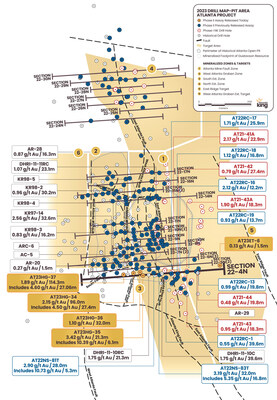NEVADA KING MAKES BLIND DISCOVERY INTERCEPTING 1.89 G/T AU OVER 114.3M AND 2.15 G/T AU OVER 96.0M 200M SOUTH OF THE ATLANTA PIT IN THE ';SOUTH QUARTZITE RIDGE TARGET'
- None.
- None.
Insights
Analyzing...
Highlights:
Hole No. | From (m) | To (m) | Interval (m) | Au (g/t) | Ag (g/t) | |
AT23HG-37 | 170.7 | 285.1 | 114.3 | 1.89 | 2.8 | |
Includes | 222.6 | 227.1 | 27.06 | 4.60 | 17.9 | |
AT23HG-34 | 135.7 | 231.7 | 96.0 | 2.15 | 5.1 | |
Includes | 202.7 | 231.7 | 27.4 | 4.50 | 13.3 | |
AT23HG-35 | 134.1 | 155.5 | 21.3 | 3.42 | 9.3 | |
Includes | 147.9 | 154.0 | 6.1 | 10.39 | 22.0 | |
AT23HG-36 | 143.3 | 175.3 | 32.0 | 1.10 | 2.7 | |
Table 1. Highlight holes released today. Mineralization occurs along near-horizontal horizons with true mineralized thicknesses in vertical holes estimated to be |
- AT23HG-34 drilled along the West Atlanta Fault ("WAF") and returned 2.15 g/t Au over 96m, including 4.50 g/t Au over 27.4m. AT23HG-37 was collared 36m west of AT23HG-34 in Eureka Quartzite and drilled through 170m of barren, Ordovician-age quartzite before intersecting Tertiary-age volcanic-hosted mineralization returning 1.89 g/t Au over 114.3m including 27.06 g/t Au over 4.6m.
- The presence of high-grade oxide mineralization beneath the Eureka Quartzite in AT23HG-37 is considered a major development as it indicates strong potential for extending the
Atlanta resource zone southward into the South Quartzite Ridge Target ("SQRT"). The SQRT is an undrilled target area measuring approximately 1,000m long x 200m wide that is contiguous to theAtlanta resource area and on trend with the major faults that are interpreted as the primary plumbing for the mineralizing fluids that deposited high-grade gold atAtlanta . These major feeder structures include the WAF, theWest Atlanta #1 and #2 Faults, theAtlanta King Fault, and the East Atlanta Fault, (see Figures 1 and 3 where fault traces are plotted in plan). - Previous explorers believed that gold mineralization terminated at the easterly trending South Fault and saw no potential for a southward continuation of mineralization along the WAF and into the SQRT. As seen in Figure 2, the South Fault appears to have no connection with gold mineralization and is instead most likely a post-mineral structure, while the mineralized WAF continues south into the SQRT. Past operators did conduct limited drilling to test south of the South Fault, but utilized angle holes that generally missed the mineralized horizon. As such, no historical drilling was conducted south of Section 22-4N leaving the SQRT undrilled.
- CSAMT lines crossing the ridge show a resistivity low where the SQRT is projected beneath the Eureka Quartzite extending several hundred metres south of Section 22-4N, which may be correlative with the mineralization hit in AT23HG-37 (Figures 3 and 4).
- As shown in Figure 2, the total width of mineralization across Section 22-4N is 375m. Mineralization to the west approaching the West Atlanta Fault #2 remains open and untested. It is also evident in Figure 2 that a close spatial (if not genetic) relationship exists between the rhyolitic intrusions and gold mineralization hosted in adjacent silica breccia and silicified volcanics. The main intrusive body is interpreted to have migrated up along the WAF and spread both westward and eastward along the Ordovician-Tertiary unconformity, localizing gold mineralization within the intrusion and in adjacent silica breccia and silicified volcanics. The stair-like arrangement of fault blocks forming the AMFZ is very apparent.
Cal Herron, Exploration Manager of
The overall north-south trend to mineralization at
Hole AT23HG-37 along Section 22-4N was sited on the northern end of the SQRT in order to test for mineralization underneath the quartzite. The hole collared in massive quartzite and drilled out of largely barren quartzite and into mineralized felsic intrusive tuff and rhyolite at 175m depth, with mineralization continuing to 285m. The contact between intrusive tuff and unaltered Pogonip Limestone was hit at 430m depth. This stratigraphic sequence is seen reflected in the resistivity section shown in Figure 4 along CSAMT Line 09, which crosses the Quartzite Ridge about 25m south of drill line 22-04N. Projecting the hit in AT23HG-37 southward onto Line 09, the hole would penetrate the gold zone 40m west of the West Atlanta Fault. This same stratigraphic profile is repeated southward past CSAMT Line 07 more than 400m south of AT23HG-37, which now opens up a large area along the anticlinal axis in which to pursue the type of thick mineralization penetrated in holes AT23HG-37 and AT23HG-034, within a part of the property that has never been previously drill-tested.
Hole No. | From (m) | To (m) | Interval (m) | Au (g/t) | Ag (g/t) |
AT23HG-37 | 170.7 | 285.1 | 114.3 | 1.89 | 2.8 |
Includes | 222.6 | 227.1 | 4.60 | 27.06 | 17.9 |
AT23HG-34 | 135.7 | 231.7 | 96.0 | 2.15 | 5.1 |
Includes | 202.7 | 231.7 | 4.50 | 27.4 | 13.3 |
AT23HG-35 | 134.1 | 155.5 | 21.3 | 3.42 | 9.3 |
Includes | 147.9 | 154.0 | 6.1 | 10.39 | 22.0 |
AT23HG-36 | 143.3 | 175.3 | 32.0 | 1.10 | 2.7 |
AT23ET-6 | 13.7 | 15.2 | 1.5 | 0.133 | <0.5 |
Table 2. All holes released today. Mineralization occurs along sub-horizontal horizons generally dipping gently westward; true mineralized thickness in vertical holes is between |
Hole No. | From (m) | To (m) | Interval (m) | Au (g/t) | Ag (g/t) | |
AT22NS-81T* | 101.8 | 129.9 | 28.0 | 2.90 | 8.1 | |
Includes | 123.2 | 128.5 | 5.3 | 10.73 | 21.4 | |
AT22NS-83T* | 96.6 | 128.7 | 32.0 | 3.19 | 14.6 | |
Includes | 110.4 | 127.1 | 16.8 | 5.35 | 24.1 | |
AT22RC-1 | 48.8 | 88.4 | 39.6 | 0.55 | 4.5 | |
AT22RC-13 | 0.0 | 19.8 | 19.8 | 0.99 | 7.4 | |
AT22RC-16+ | 6.1 | 18.3 | 12.2 | 2.12 | 10.5 | |
AT22RC-17 | 33.5 | 59.5 | 25.9 | 1.71 | 20.7 | |
AT22RC-18 | 9.1 | 25.9 | 16.8 | 1.12 | 10.3 | |
AT22RC-19 | 9.1 | 22.9 | 13.7 | 0.93 | 11.3 | |
AT21-41A | 38.1 | 61.0 | 22.9 | 2.17 | 33.7 | |
AT21-42 | 9.1 | 36.6 | 27.4 | 0.79 | 3.3 | |
AT21-43 | 10.7 | 29.0 | 18.3 | 0.95 | 10.0 | |
AT21-43A | 10.7 | 29.0 | 18.3 | 1.90 | 18.6 | |
AT21-44 | 4.6 | 24.4 | 19.8 | 0.48 | 4.1 | |
Table 3. Previously reported holes used in previous releases along trace of Section 22-4N. AT22 series holes were drilled by |
Hole No. | From (m) | To (m) | Interval (m) | Au (g/t) | Ag (g/t) |
KR98-2^ | 201.7 | 231.8 | 30.2 | 0.96 | 6.82 |
KR98-3^ | 202.9 | 219.1 | 16.2 | 0.83 | 0.9 |
KR98-4^ | 0.0 | 99.1 | 99.1 | <0.02 | <0.8 |
KR98-5^ | 0.0 | 138.7 | 138.7 | <0.035 | <1.0 |
KR97-14^ | 177.9 | 210.5 | 32.6 | 2.56 | 2.1 |
AR-20 | 114.3 | 115.9 | 1.5 | 0.27 | 0.1 |
AR-28^ | 130.4 | 146.7 | 16.3 | 0.87 | 6.2 |
AR-29 | 0.0 | 152.4 | 152.4 | <0.003 | <0.1 |
ARC-6 | 0.0 | 230.2 | 230.2 | <0.003 | <1.0 |
AC-5* | 0.0 | 99.7 | 99.7 | <0.003 | <1.0 |
DHRI-11-10RC | 108.2 | 129.6 | 21.3 | 1.75 | 10.6 |
DHRI-11-11RC^ | 88.3 | 111.4 | 23.1 | 1.07 | 5.1 |
DHRI-11-10C* | 74.7 | 114.3 | 39.6 | 1.75 | 23.1 |
Table 4. Historical holes used in Section 22-4N. KR97 and KR98 series holes were drilled by |
Operator | West Atlanta Graben | Atlanta Mine Fault Zone | ||||
No. of | Average AuEq. | Average | No. of | Average Au Eq | Average | |
2 | 2.05 | 105.2 | 15 | 1.76 | 23.2 | |
Historical | 3 | 1.64 | 26.3 | 4 | 1.61 | 25.0 |
Table 5. Comparison of |
All Reverse Circulation (RC) samples from the Atlanta Project are split at the drill site and placed in cloth and plastic bags utilizing a nominal 2kg sample weight. CRF standards, blanks, and duplicates are inserted into the sample stream on-site on a one-in-twenty sample basis, meaning all three inserts are included in each 20-sample group. Samples are shipped by a local contractor in large sample shipping crates directly to American Assay Lab in
The scientific and technical information in this news release has been reviewed and approved by Calvin R. Herron, P.Geo., who is a Qualified Person as defined by National Instrument 43-101 ("NI 43-101").
The Atlanta Mine is a historical gold-silver producer with a NI 43-101 compliant pit-constrained resource of 460,000 oz Au in the measured and indicated category (11.0M tonnes at 1.3 g/t) plus an inferred resource of 142,000 oz Au (5.3M tonnes at 0.83 g/t). See the NI 43-101 Technical Report on Resources titled "Atlanta Property,
Resource Category | Tonnes (000s) | Au Grade (ppm) | Contained Au | Ag Grade (ppm) | Contained Ag |
Measured | 4,130 | 1.51 | 200,000 | 14.0 | 1,860,000 |
Indicated | 6,910 | 1.17 | 260,000 | 10.6 | 2,360,000 |
Measured + Indicated | 11,000 | 1.30 | 460,000 | 11.9 | 4,220,000 |
Inferred | 5,310 | 0.83 | 142,000 | 7.3 | 1,240,000 |
Table 6. NI 43-101 Mineral Resources at the Atlanta Mine |
Please see the Company's website at www.nevadaking.ca.
Neither the TSX Venture Exchange nor its Regulation Services Provider (as that term is defined in the policies of the TSX Venture Exchange) accepts responsibility for the adequacy or accuracy of this release.
This news release contains certain "forward-looking information" and "forward-looking statements" (collectively "forward-looking statements") within the meaning of applicable securities legislation. All statements, other than statements of historical fact, included herein, without limitation, statements relating the future operations and activities of
![]() View original content to download multimedia:https://www.prnewswire.com/news-releases/nevada-king-makes-blind-discovery-intercepting-1-89-gt-au-over-114-3m-and-2-15-gt-au-over-96-0m-200m-south-of-the-atlanta-pit-in-the-south-quartzite-ridge-target-301958312.html
View original content to download multimedia:https://www.prnewswire.com/news-releases/nevada-king-makes-blind-discovery-intercepting-1-89-gt-au-over-114-3m-and-2-15-gt-au-over-96-0m-200m-south-of-the-atlanta-pit-in-the-south-quartzite-ridge-target-301958312.html
SOURCE Nevada King Gold Corp.











